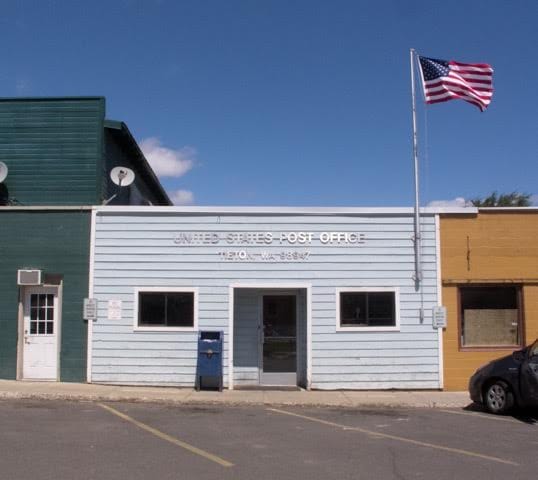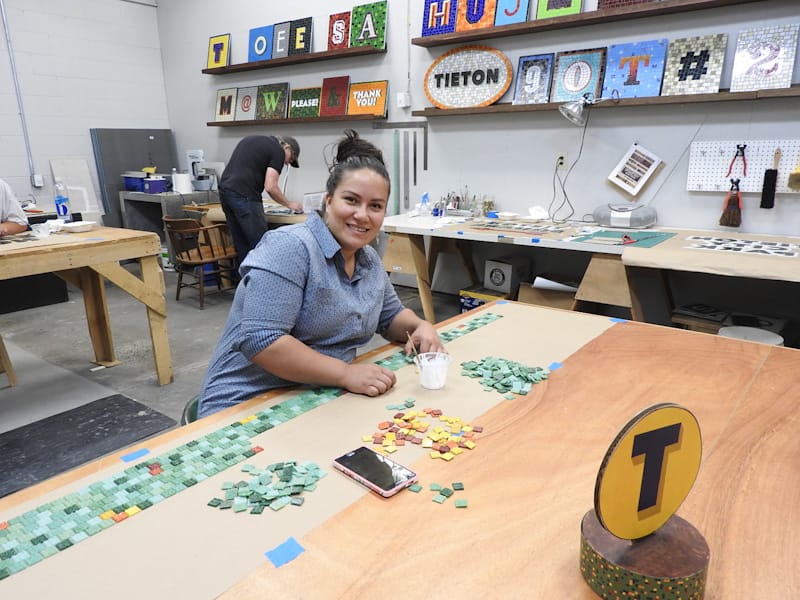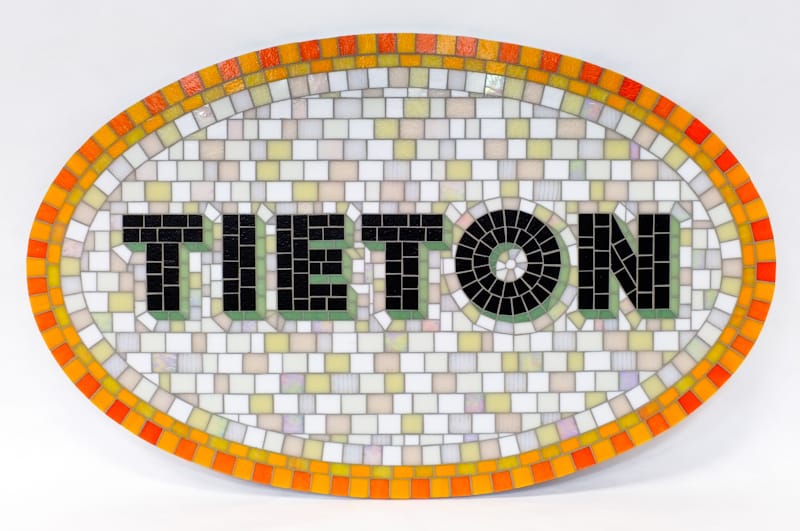It’s a design that gives a whole new meaning to the term “post office wall.” It’s a project that might make tiny Tieton, Washington’s post office one of the most celebrated in the world, a beacon for reviving post offices and small towns everywhere. It’s a gift that many a flailing, red-ink-soaked organization might gladly grasp. But the U.S. Postal Service isn’t just any organization.
Last winter an energetic team of Tieton entrepreneurs and artists offered to replace the rotting siding fronting the local post office with a gorgeous $48,000 façade for the ages, in perdurable glass-tile mosaic.
It would be what the project’s prime mover, publisher and artisan-business impresario Ed Marquand, calls “the crown jewel” in a series of glass-mosaic signworks – co-funded by the National Endowment for the Arts and created right there in Tieton, 15 miles northwest of Yakima. (The name means “roiling waters,” as in the Tieton River.)
The Tieton Stamp Mosaic would honor both the town’s and the Postal Service’s civic and graphic heritages. Its design celebrates the can-do optimism expressed in mid-20th century U.S. postage stamps and in Tieton’s own reincarnation as a seedbed of creative industry. It would be an instant hit with anyone who ever collected stamps or delighted in their designs, and an inspiration to hometown heroes everywhere trying to reinvigorate fading rural communities.

According to Marquand, when his artisan-business incubator Mighty Tieton presented the idea to Tieton postmaster Cindy England, “she said, ‘That looks nice, I’ll check with my superiors.’ They approved it and she said, ‘Go for it.’” When I called England to confirm, she said she’d been directed not to discuss the matter.
England and Marquand signed memos of understanding in February and July. On July 1, Mighty Tieton launched a Kickstarter campaign to fund the Stamp Mosaic and create “the coolest post office in America.” With seven days to go, it’s drawn 276 pledges and surpassed its $48,000 goal. That works out to about $1.16 per custom-made glass tile. Projected completion: November 2015.
And then the U.S. Postal Service brass in the other Washington took note. On July 15, Tom Samra, USPS’s vice president for facilities, wrote (by certified letter, of course) ordering Marquand to cease and desist. (See Samra's letter and the MOUs.) According to Samra, postmaster England hadn’t sought approval and lacked authority: “Agreements related to the sale or alteration of postal owned [sic] facilities must be handled by appropriate officials in the Facilities Department…. In addition, any proposals related to potential intellectual property must be reviewed and approved by a Vice President. In general, the Postal Service does not accept gifts of art or sculpture for our facilities.”
There are several ironies here. The Tieton Post Office was itself a gift, donated by a member of the same community that seeks to recover its façade now. It’s true that USPS doesn’t waste space that could go to tie-in merchandising on artwork these days. But back in the 1930s, when it was still the U.S. Post Office, it did, to its lasting glory: Federal art projects placed splendid murals by the likes of Kenneth Callahan and Peter Hurd in small-town post offices across the land.

The Tieton Stamp Mosaic is meant to reprise the distinctive designs, at once stately and whimsical, and “engraved” textures of classic intaglio-printed stamps. But it also recalls those murals, and the monumental status that post offices once enjoyed. “That was an entirely different era," says USPS district spokesperson Ernie Swanson. "Back then we part of the federal government” – before Congress spun off the Postal Service to succeed as an ostensible business, while loading it with enough poison pills to ensure it never could.
As for “alteration,” the mosaic would, in functional terms, be merely a timely recladding of the building’s cement-block wall. “The first two feet of wood slats are rotten,” notes Marquand. “In the lobby, whenever a linoleum tile pops up from the floor, they have to stick it down with duct tape. That’s how much Facilities in D.C. cares about this building. If [England] had said we’re going to cover the whole façade in white tile, I don’t think there would be a problem.”
The Postal Service's posted protocols state that postmasters can undertake "projects that do not expand the footprint of the [post office], such as painting, repairs, replacement, or upgrade," without soliciting public input, but don't speak to internal authorization.
Marquand contends it was using an image that “got them all lathered up.” Indeed, that image celebrates a legacy the Postal Service often seems determined to shed, as it cuts deals for issues honoring the likes of Star Wars and Harry Potter in a frantic bid to sell souvenir stamps to younger consumers who don’t use, much less collect, much of anything on paper.
Still, even if England did get permission from her district supervisor, it’s not surprising that the central office would want to check out so novel a project and make sure copyright and other Ts get crossed. But Samra’s letter doesn’t ask the Mighty Tietonites to provide more information. Instead it thanks them for their interest and tells them to buzz off: “We regret to inform you that we are not interested in pursuing the project at this time.”
“For a week we’ve been trying to get the Postal Service in D.C. and Seattle to communicate with us and tell us how this can go forward.” says Marquand. “If we have to modify the design to suit guidelines, tell us how. Tell us what the guidelines are. They’ve simply stonewalled it – no response whatsoever.”
USPS vice president Samra did not return my call either. Postmaster England referred me to spokesperson Swanson, who reiterated the points in Samra’s letter.
The Postal Service hasn’t just shut down a community’s flagship project. It’s rebuffed one of the Postal Service’s biggest fans and its best local customer. Marquand enthuses – on the project’s Kickstarter page and even now – over the post office’s essential role in civic life, the Tieton community, and his own business. “Part of our motivation is to recognize and support the post office,” he says. “For many retired people, picking up the mail each day is the reason to get out of the house. It really is the lifeblood of small-town life for many of them. They don’t do email, internet, any of that stuff. This is where they get their Medicare notices and social security checks, send their cookies to far-off lands.”

The Tieton Post Office also has an unexpected part in the global economy. Marquand, then a Seattle-based publisher of super-limited edition art books, stumbled on (and into) Tieton 10 years ago. As he tells it, he was biking over the nearby lava fields when goathead thorns pierced his tires. “I looked around, saw all these empty spaces, and thought, Gee, what would happen if you put them together with creative people who can’t afford space in Seattle anymore?”
Marquand has since set up in Tieton, complete with letterpress, and attracted 10 more artisan enterprises, among them what he says is the only typographical mosaic studio in the United States. It courts architects and builders nationwide. Marquand and his partner operate a book-distribution company, one of whose clients is Tim Burton’s Steele Publishing. “Whenever Tim posts about a book on Facebook, the orders roll in,” he says. “I couldn’t do it without the Postal Service. They have a fantastic parcel service.” Not always cheap, of course: It can cost $70 to send a book to Burton fans in Australia. “We’ve spent about $15,500 on postage just this year.”
But it wasn’t Marquand who thought of redecorating the post office façade. Teresa Pritchard, the HR manager at a Yakima fruit company (and daughter-in-law of the late congressman and lieutenant governor Joel Pritchard) attended a mosaic workshop in Tieton – the sort of thing she says attracts more and more orchard-country folks around Yakima. “They were talking about what might be done with all the buildings in town,” she recalls, “Just out of the blue, I said to the person beside me, ‘They should turn the post office into a giant stamp.’” That person passed the idea along, and the rest is history, albeit unconsummated.
“I’m sure it will all work out,” says Pritchard cheerily. “There will be a media uproar over this, and the Postal Service will let us do it. The more vibe there is about the project, the more people get excited.”
But so far the uproar has been confined to Yakima’s newspaper and TV stations. And Marquand worries that one more concern may make the Postal Service dig in its heels. “I can imagine them thinking, ‘Oh God, every small town in America is going to want to do something with its post office.’”
His advice: don’t worry. “If everybody wants to get behind their post office, why not? It might be the best business decision the Postal Service ever makes.”
UPDATE, 7/28 5pm: Tieton's Ed Marquand reports that the U.S. Postal Service's vice president for facilities, Tom Samra, finally called to explain his agency's rejection of the Stamp Mosaic, even before this story spread on Twitter and the art blogs. "He was very gracious – he c0uldn't have been more complimentary of our effort and the community support we built. He said much as they'd like to do it, they can't. A successful project would engender thousands of other towns wanting to decorate their post offices, and the Postal Service just doesn't have the management structure to process the requests. As a businessman, I can see his point – belatedly. So Mighty Tieton is cancelling this stamp. "Now we have to scramble to find some commercial work for the mosaic artists and apprentices we brought in for the project."




